The location of significant ancient history, which provides popular modern day tourist destinations.
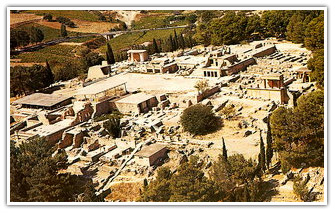 Knossos is the site of the most important and better known palace of Minoan civilization. According to tradition, it was the seat of the legendary king Minos. The Palace is also connected with thrilling legends, such as the myth of the Labyrinth with the Minotaur, and the story of Daidalos and Icaros.
The site was continuously inhabited from the Neolithic period (7000-3000 B.C.) until Roman times.
The Linear B tablets (Mycenaean script) of the 14th century B.C. mention the city as ko-no-so.
Intensive habitation occured mostly in the Minoan period, when the so-called first (19th-17th centuries B.C.) and second palaces (16th-14th centuries B.C.) were built along with luxurious houses, a hospice and various other structures. After its partial destruction in 1450 B.C., Knossos was settled by Mycenaeans from the Greek Mainland.
The city flourished again during the Hellenistic period (sanctuaries of Glaukos, Demeter, other sanctuaries, chamber tombs, north cemetery, defensive towers) and in 67 B.C. it was captured by the Roman Quintus Caecilius Metelus Creticus. The "Villa of Dionysos", a private house with splendid mosaics was built in the same period.
Knossos is the site of the most important and better known palace of Minoan civilization. According to tradition, it was the seat of the legendary king Minos. The Palace is also connected with thrilling legends, such as the myth of the Labyrinth with the Minotaur, and the story of Daidalos and Icaros.
The site was continuously inhabited from the Neolithic period (7000-3000 B.C.) until Roman times.
The Linear B tablets (Mycenaean script) of the 14th century B.C. mention the city as ko-no-so.
Intensive habitation occured mostly in the Minoan period, when the so-called first (19th-17th centuries B.C.) and second palaces (16th-14th centuries B.C.) were built along with luxurious houses, a hospice and various other structures. After its partial destruction in 1450 B.C., Knossos was settled by Mycenaeans from the Greek Mainland.
The city flourished again during the Hellenistic period (sanctuaries of Glaukos, Demeter, other sanctuaries, chamber tombs, north cemetery, defensive towers) and in 67 B.C. it was captured by the Roman Quintus Caecilius Metelus Creticus. The "Villa of Dionysos", a private house with splendid mosaics was built in the same period.
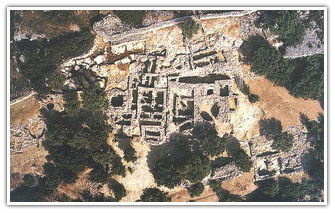 Excavations at Phourni have brought to light 26 buildings, most of which had funerary use. The cemetery was used from 2400 B.C. until 1200 B.C. and each complex had more than one architectural phase. Most of the funerary buildings were used for many decades and contain successive burials. Excavations were begun in 1964 by Efi and John Sakellarakis and have been continued until today (1995) with short interruptions. Most of the buildings are preserved in good condition.
Excavations at Phourni have brought to light 26 buildings, most of which had funerary use. The cemetery was used from 2400 B.C. until 1200 B.C. and each complex had more than one architectural phase. Most of the funerary buildings were used for many decades and contain successive burials. Excavations were begun in 1964 by Efi and John Sakellarakis and have been continued until today (1995) with short interruptions. Most of the buildings are preserved in good condition.
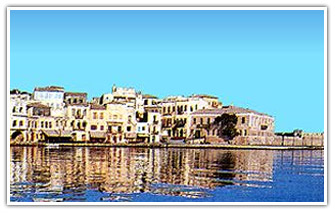 The museum is housed in the katholikon of the Venetian monastery of St. Francis. During the period of the Turkish occupation it was the Muslim mosque of Yussuf Pasha, while in modern times it was used as a cinema or a storehouse for military equipment. Since 1963 it has been functioning as the Archaeological Museum of the city. Apart from the permanent exhibition, the museum houses temporary exhibitions in the frame of certain local events (such as the exhibition of musical instruments or on the birth of writing), as well as music concerts.
The museum is housed in the katholikon of the Venetian monastery of St. Francis. During the period of the Turkish occupation it was the Muslim mosque of Yussuf Pasha, while in modern times it was used as a cinema or a storehouse for military equipment. Since 1963 it has been functioning as the Archaeological Museum of the city. Apart from the permanent exhibition, the museum houses temporary exhibitions in the frame of certain local events (such as the exhibition of musical instruments or on the birth of writing), as well as music concerts.
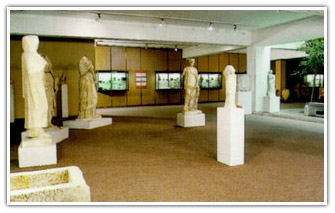 Since 1991, the Archaeological Museum of Rethymnon has been housed in the pentagonal building opposite the main gate of the Fortetsa. The building was constructed by the Turks in an effort to strengthen the city's defence. Due to the different functions that it served over the centuries - until the 1960's it housed the civic prison - its original form has been significantly altered. The museum contains the following collections: Late Neolithic (3500-2900 B.C.) and Early Minoan (2800-2100 B.C.) finds from the caves Gerani, Melidoni, Margeles and Helenes finds from the buildings at Apodoulou, Monastiraki and the peak sanctuary at Vrysinas, dated to the Middle Minoan period (2100-1600 B.C.) Late Minoan finds (1600-1100 B.C.) from the cemeteries, the most representative being that of Armenoi finds of the Geometric (1000-700 B.C.) and Archaic (700-500 B.C.) periods from Eleutherna and Axos finds from Stavromenos and Argyroupolis (ancient Lappa) dated to the Classical, Hellenistic and Roman periods.
Since 1991, the Archaeological Museum of Rethymnon has been housed in the pentagonal building opposite the main gate of the Fortetsa. The building was constructed by the Turks in an effort to strengthen the city's defence. Due to the different functions that it served over the centuries - until the 1960's it housed the civic prison - its original form has been significantly altered. The museum contains the following collections: Late Neolithic (3500-2900 B.C.) and Early Minoan (2800-2100 B.C.) finds from the caves Gerani, Melidoni, Margeles and Helenes finds from the buildings at Apodoulou, Monastiraki and the peak sanctuary at Vrysinas, dated to the Middle Minoan period (2100-1600 B.C.) Late Minoan finds (1600-1100 B.C.) from the cemeteries, the most representative being that of Armenoi finds of the Geometric (1000-700 B.C.) and Archaic (700-500 B.C.) periods from Eleutherna and Axos finds from Stavromenos and Argyroupolis (ancient Lappa) dated to the Classical, Hellenistic and Roman periods.
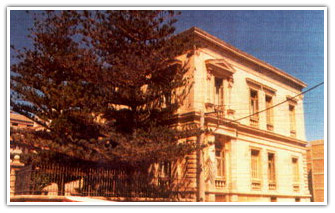 The Museum is housed in a neoclassical building which belongs to the Philanthropic Institutions A. and M. Kalokairinou. It was designed by L. Kantantzoglou and built in 1870, in the place of an older mansion. It was fired by the Turks during the events of August 25, 1898 and was reconstructed in 1903 on the plans of K.Tsantirakis (preserved today), based on the layout of the previous structure.
The Museum is housed in a neoclassical building which belongs to the Philanthropic Institutions A. and M. Kalokairinou. It was designed by L. Kantantzoglou and built in 1870, in the place of an older mansion. It was fired by the Turks during the events of August 25, 1898 and was reconstructed in 1903 on the plans of K.Tsantirakis (preserved today), based on the layout of the previous structure.
It has been declared a Historical Building and a Work of Art and is protected by a preservation order. The two-storeyed building is a wonderful specimen of the Neoclassical architecture. Its entrance is formed by a marble porch and columns made of poros stone. The windows on the facade of the ground floor and in the south part of the east and west walls are crowned by arched lintels and framed by caryatids (Hermae) supporting a pediment. The rest of the windows have plain, rectangular frames. The north side of the building is modelled as a "scarpa" following the Venetian model. The courtyard on the south side of the building is enclosed by a Neoclassical fence. The interior is decorated with friezes depicting scenes from the Iliad and the Odyssey.
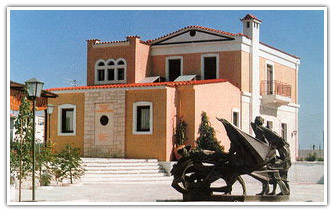 The Kazantzakis Museum is situated in Varvaroi, approximately 20 km. to the south of Heraklion. It was founded to preserve the work and to record the life of the Cretan writer. It includes some of the writer's personal belongings and those of his family, documents, letters, the first Greek editions of his books, and translations in 49 languages in 54 counties, photographs, busts, works of art, as well as documents referring to stagings of his theatrical works and of novels adapted for the theatre, posters, programmes, models of stage settings and costumes as they have been presented in performances al over the world. There is also radio and television material as well as a collection of press reviews which refer to Kazantzakis and have been published in Greek and foreign newspapers.
The Kazantzakis Museum is situated in Varvaroi, approximately 20 km. to the south of Heraklion. It was founded to preserve the work and to record the life of the Cretan writer. It includes some of the writer's personal belongings and those of his family, documents, letters, the first Greek editions of his books, and translations in 49 languages in 54 counties, photographs, busts, works of art, as well as documents referring to stagings of his theatrical works and of novels adapted for the theatre, posters, programmes, models of stage settings and costumes as they have been presented in performances al over the world. There is also radio and television material as well as a collection of press reviews which refer to Kazantzakis and have been published in Greek and foreign newspapers.
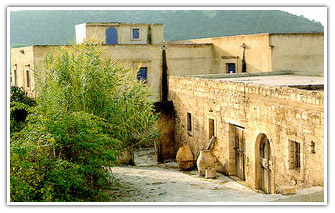 The Museum of Cretan Ethnology is situated 2 km from the Minoan palace of Phaestos, in the traditional settlement of Voroi.
The Museum of Cretan Ethnology is situated 2 km from the Minoan palace of Phaestos, in the traditional settlement of Voroi.
The exhibition was inaugurated in 1988 and was awarded a prize in 1992 by the Council of Europe. The exhibition, which is based on the museological model of G. H. Riviere, includes objects pertaining to the traditional everyday life in Crete. It is divided into 7 sections under the following headings: Food, Architecture, Weaving, Production, Transport, Customs and Traditions, Social Organization. In the Museum a Research Centre of the Cretan ecosystem is in operation, studying the traditional human activities from the Middle Ages to our day, through the historical and social developments of Crete, the political history of the general area and the geophysical enviroment of the island. To date, 14 volumes have been published on subjects referring to the island's architecture, traditional crafts, economy etc.
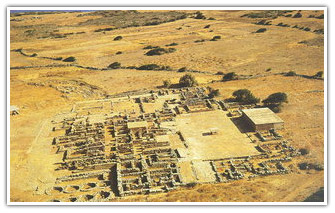 Human presence at Malia during the Neolithic period (6000-3000 B.C.) is attested only by potsherds, but habitation was continuous from the middle of the 3rd millennium B.C. until the end of Prehistory. Houses of a Prepalatial settlement (2500-2000 B.C.) have been found under the palace, while graves of the same period are located near the sea. The first palace was built in around 2000-1900 B.C.
Human presence at Malia during the Neolithic period (6000-3000 B.C.) is attested only by potsherds, but habitation was continuous from the middle of the 3rd millennium B.C. until the end of Prehistory. Houses of a Prepalatial settlement (2500-2000 B.C.) have been found under the palace, while graves of the same period are located near the sea. The first palace was built in around 2000-1900 B.C.
The already existing significant settlement of which are preserved parts around the palace, was then converted into a palatial centre-city.
The palace was destroyed in around 1700 B.C. and rebuilt in 1650 B.C. at the same site, following the plan of the older palace, while a few changes took place 50 years later.
The destruction of the new palace came in c. 1450 B.C., along with the destruction of the other Minoan palatial centres. The site was reoccupied for a short period in the 14th-13th century B.C. Remains of a Roman settlement cover an extensive area at the site called "Marmara", where a basilica of the 6th century is also preserved.
The English admiral Th. Spratt, who travelled in Crete in the middle of the 19th century, reports the finding of gold sheets at the site "Helleniko Livadi". In 1915, Joseph Chatzidakis started a trial excavation on the hill called "Azymo", and brought to light the southern half of the west wing of the palace, as well as the tombs by the sea, but he stopped the investigation. Finally, the French School of Archaeology at Athens resumed the excavations, which are continued until today with intervals, at the palace, the sectors of the town and the cemeteries on the coast.
The results have been published in the series of "Etudes Cretoises" since 1928, and in the works of H. Van Effenterre and O. Pelon. The finds are exhibited in the Museum of Heraklion, and some in the Museum of Aghios Nikolaos.
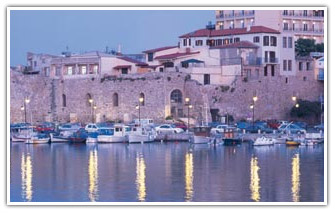 Located almost in the center of Crete, Heraklion has since the early years played a significant part in the history of the island. It has worn different names during the years: Heraklion, Hanclakas, Candi and Heraklion again, officially in 1922. The city of today is modern and large commercial, industrialand agrarian, provincial center. As the largest communication center of Crete it is connected with our country's largest cities and with several foreign cities. Heraklion's long-lasting history has contributed to the existence of a significant cultural and intellectual movement. The new quarters do not have anything special to present. They remind us mostly of large cities in other parts of Greece. Yet the part of the city surrounded by the famous Venetian walls has preserved many picturesque spots and monuments, standing as reliable witnesses of its history, Once you had to pass through the gates of the wall if you wished to enter the city. Today only two of the four gates are preserved: the Gate of Pantokrator (or the Chania Gate) on the west side and the Gate of lisous (the new gate) along the southern side of the wall. At the southernmost point of the peribolus is the Martinengo bastion, the highest point of the castle and furthermore impregnable. Here is also the grave of the famous Nikos Kazantzakis. On a stoneplate you can read the inscription of a phrase stated by the author, "I hope nothing, I fear nothing, I am free".
Located almost in the center of Crete, Heraklion has since the early years played a significant part in the history of the island. It has worn different names during the years: Heraklion, Hanclakas, Candi and Heraklion again, officially in 1922. The city of today is modern and large commercial, industrialand agrarian, provincial center. As the largest communication center of Crete it is connected with our country's largest cities and with several foreign cities. Heraklion's long-lasting history has contributed to the existence of a significant cultural and intellectual movement. The new quarters do not have anything special to present. They remind us mostly of large cities in other parts of Greece. Yet the part of the city surrounded by the famous Venetian walls has preserved many picturesque spots and monuments, standing as reliable witnesses of its history, Once you had to pass through the gates of the wall if you wished to enter the city. Today only two of the four gates are preserved: the Gate of Pantokrator (or the Chania Gate) on the west side and the Gate of lisous (the new gate) along the southern side of the wall. At the southernmost point of the peribolus is the Martinengo bastion, the highest point of the castle and furthermore impregnable. Here is also the grave of the famous Nikos Kazantzakis. On a stoneplate you can read the inscription of a phrase stated by the author, "I hope nothing, I fear nothing, I am free".
At the old town's centre we meet the Square of Venizelos with the Venetian Morozini Fountain. The basilica of St. Mark, the Venetian Lotzia, beautiful fountains, old churches such as Agios Titos,the fortress, the Venetian shipyards and many more scattered monuments make our walk through the city.
A visit to Heraklion's Archaeological Museum is a must. You can see one of the world's most important collections with objects from Knossos, Phaistos, Gortyna, Arhanes and of other places on Crete. Nearby is the Historical Ethnographic Museum and ecclesiastical works of art. The local specialty of Heraklion is Hochli(snails) cooked in different ways. If you taste them without being to Id what it is, you will find them delicious. In Heraklion's 11 rakadika" you can enjoy the traditional " mezedes (appetisers) , baked potatoes 11 oftes patates", tasty cheeses and olives. The traditional Cretan sweets are "Kaltsounia" which you can find anywhere on the island. Don't forget to visit the "mahairadika", workshops where the famous Cretan knives are made by experienced hand crafters.
Near Heraklion you can swim at the organized beaches of Ammoudara, Linoperamata and Kartero. Here we also find the ruins Of the Minoan city of Amnisos and a villa with impressive frescos. In the same area the Cave of Eileithias is situated, which was the sanctuary of the goddess of fertility, in 1545, at the Picturesque village of Fodele Domenikos Theotokopoulos was born, more famous under the name of El Greco, one of the greatest painters Of the Renaissance period. Brilliant palaces and magnificent residences surrounded Heraklion during antiquity. The Minoan civilization flourished in Crete from 3000 to 1200 13C and was considered to be one of the most important in Greece. While it lasted, more than one hundred cities prospered and grew into significant centres of civilization. The Most well- known are Knossos, Phaistos, Malia, Gortys, Zakros and Arhanes. Most Of them were repeatedly destroyed by earthquakes and other natural phenomenon but each time they were rebuilt and were more magnificent than before. In the Minoan Civilization's Golden Age (1700 -1450 BC) art evolved in this cities leaving us a significant cultural inheritance and Considerable unique findings. Knossos is Crete's most significant archaeological site It was here that Arthur Evans" the English archaeologist discovered the ruins of the greatest and most luxurious Minoan palace. The first palace was built around 2000 BC and was destroyed some 300 years later. It was quickly rebuilt, this time more imposing and more magnificent than before thus marking the Neoanactoric
 Classified as a National park, Samaria Gorge is one of the most spectacular natural parks in Europe. Starting south of the settlement of Omalos, 42 Km south of Hania, spans for 18 Km as far as the south Crete coast. The only way to see the gorge is to walk through its entire length, sometime between May and October when passage is permitted, but rest assured that the five or so hours that you spend in this gorge will award you with incredible views. Take the pedestrian path walk at Xyloskalo, the gorge's entrance, and start your descend in the gorge. After about three hours of walk at a normal pace, you will have descended by 700 meters of altitude on a zigzag path that brings you to the deserted village of Samaria with its 14th century chapel. You will notice that although the sun is high in the sky, the gorge is always in the shadow. Used as a hide out during war years, is now haunted by the Cretan "ibex" known as "Kri-Kri", the chin bearded wild goat of Crete with thick, curved, ridged horns, and only if you are lucky you might catch a glimpse of one. Equally rare is "Dictamon" a herb very much appreciated locally, found on the cliffs of the gorge. One mile before Agia Roumeli at the southern exit of the gorge, is the famous "Sideroportes"(Iron Gate), where the rock wall rises 300 meters on either side of the passage, only 3 meters wide. Remember that the walk through is a one way venture as you start from an altitude of about 800m above sea level going down to zero. For this reason you will probably use public transport from Hania to arrive early morning in Omalos, and at midday you can catch a boat from Agia Roumeli to Chora Sfakion. From there, again by bus, you will arrive exhausted back to Hania to meet your transport. Alternatively you can buy this excursion as a package sold locally in many resorts. You will be picked up from your hotel, very early in the morning and will be brought back in the evening. A slightly more expensive method but worth trying it.
Classified as a National park, Samaria Gorge is one of the most spectacular natural parks in Europe. Starting south of the settlement of Omalos, 42 Km south of Hania, spans for 18 Km as far as the south Crete coast. The only way to see the gorge is to walk through its entire length, sometime between May and October when passage is permitted, but rest assured that the five or so hours that you spend in this gorge will award you with incredible views. Take the pedestrian path walk at Xyloskalo, the gorge's entrance, and start your descend in the gorge. After about three hours of walk at a normal pace, you will have descended by 700 meters of altitude on a zigzag path that brings you to the deserted village of Samaria with its 14th century chapel. You will notice that although the sun is high in the sky, the gorge is always in the shadow. Used as a hide out during war years, is now haunted by the Cretan "ibex" known as "Kri-Kri", the chin bearded wild goat of Crete with thick, curved, ridged horns, and only if you are lucky you might catch a glimpse of one. Equally rare is "Dictamon" a herb very much appreciated locally, found on the cliffs of the gorge. One mile before Agia Roumeli at the southern exit of the gorge, is the famous "Sideroportes"(Iron Gate), where the rock wall rises 300 meters on either side of the passage, only 3 meters wide. Remember that the walk through is a one way venture as you start from an altitude of about 800m above sea level going down to zero. For this reason you will probably use public transport from Hania to arrive early morning in Omalos, and at midday you can catch a boat from Agia Roumeli to Chora Sfakion. From there, again by bus, you will arrive exhausted back to Hania to meet your transport. Alternatively you can buy this excursion as a package sold locally in many resorts. You will be picked up from your hotel, very early in the morning and will be brought back in the evening. A slightly more expensive method but worth trying it.
 Eileithyia was a goddess that protected childbirth and this cave was the most important place of her worship. According to tradition she was born by Hera inside this cave, which is also mentioned by Homer in the Odyssey (t 188). The finds proove that it was continuously used from Neolithic until late Roman times, with more intensive occupation noted for the Neolithic, Minoan, and late Roman periods. Evidence for cult practice in the Early Christian times (5th century A.D.) also exists. Restricted investigation was carried out in 1885 by Joseph Chatzidakis. The site was systematically excavated by Spyridon Marinatos in 1929-1938.
Eileithyia was a goddess that protected childbirth and this cave was the most important place of her worship. According to tradition she was born by Hera inside this cave, which is also mentioned by Homer in the Odyssey (t 188). The finds proove that it was continuously used from Neolithic until late Roman times, with more intensive occupation noted for the Neolithic, Minoan, and late Roman periods. Evidence for cult practice in the Early Christian times (5th century A.D.) also exists. Restricted investigation was carried out in 1885 by Joseph Chatzidakis. The site was systematically excavated by Spyridon Marinatos in 1929-1938.
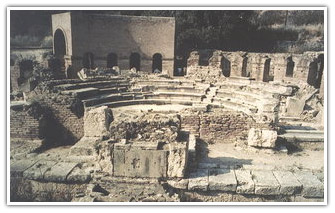 The Odeion is dated to the 1st century A.D. Beneath it there was an Archaic, round building which had the stones of the Law Code of Gortyn built in its walls. These stones were again built in the theatre of the Roman period. The Odeion was destroyed by the Arabs in A.D. 824/7. In 1884, parts of the large inscription (Code of Gortyn) were accidentally brought to light. Excavations in the area of the Odeion were begun in 1899 by F. Halbherr and L. Pernier, and completed in 1921.
The Odeion is dated to the 1st century A.D. Beneath it there was an Archaic, round building which had the stones of the Law Code of Gortyn built in its walls. These stones were again built in the theatre of the Roman period. The Odeion was destroyed by the Arabs in A.D. 824/7. In 1884, parts of the large inscription (Code of Gortyn) were accidentally brought to light. Excavations in the area of the Odeion were begun in 1899 by F. Halbherr and L. Pernier, and completed in 1921.
The Odeion has been consolidated and the north circular wall, where the inscription is built, is protected within a small structure.
The Odeion has two entrances on the north side, and an orchestra, almost semicircular in plan, lined with white and grey marble slabs. The raised stage (skene) was also paved with bricks and marbles. Four niches for statues were constructed in the north wall of the stage. Of the cavea only three rows of benches are preserved. In the north, circular wall of the Odeion, the Code of Gortyn has been built.
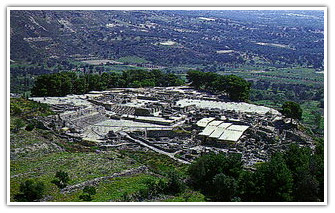 The Palace of Phaistos with its superb architectural composition and its almost perfect construction, is considered to be the finest and most typical of all Minoan palaces. The ruins of the old and new palace are preserved today, the former having been protected under a shed. The nucleus of the new palace is a central peristyle court around which the rooms are arranged: the storerooms and shrines on the west side, the royal quarters on the north and the workshops on the east. To the west of the storerooms is the "theatral area" with the "processional ways" and, in the lower strata, the granaries of the Old Palace period (first palace). The West Propylon, the monumental entrance to the palace is the most impressive known structure of its kind. The finds from the palace are now exhibited in the Archaeological Museum of Heraklion.
The Palace of Phaistos with its superb architectural composition and its almost perfect construction, is considered to be the finest and most typical of all Minoan palaces. The ruins of the old and new palace are preserved today, the former having been protected under a shed. The nucleus of the new palace is a central peristyle court around which the rooms are arranged: the storerooms and shrines on the west side, the royal quarters on the north and the workshops on the east. To the west of the storerooms is the "theatral area" with the "processional ways" and, in the lower strata, the granaries of the Old Palace period (first palace). The West Propylon, the monumental entrance to the palace is the most impressive known structure of its kind. The finds from the palace are now exhibited in the Archaeological Museum of Heraklion.
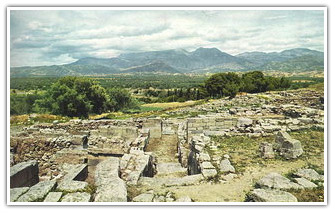 The Royal Villa was built in the 16th century B.C. (New Palace period). After the destruction of the palaces in 1450 B.C., only a small "megaron" of the "Mycenaean" type was built in their place. There is evidence that in the Geometric period (8th century B.C.) the site had religious function. In the Hellenistic period (4th-3rd centuries B.C.) the sanctuary of Zeus Velchanos was founded and much later, during the Venetian occupation, the area of the courtyard was occupied by the church of St. George Galatas (14th century A.D.). The Italian Archaeological School at Athens located and excavated the site of Aghia Triada in the years 1902, 1903, 1904-1905 and 1910-1914.
The Royal Villa was built in the 16th century B.C. (New Palace period). After the destruction of the palaces in 1450 B.C., only a small "megaron" of the "Mycenaean" type was built in their place. There is evidence that in the Geometric period (8th century B.C.) the site had religious function. In the Hellenistic period (4th-3rd centuries B.C.) the sanctuary of Zeus Velchanos was founded and much later, during the Venetian occupation, the area of the courtyard was occupied by the church of St. George Galatas (14th century A.D.). The Italian Archaeological School at Athens located and excavated the site of Aghia Triada in the years 1902, 1903, 1904-1905 and 1910-1914.
The Villa at Aghia Triada consists of two wings which form an L-shaped structure enclosing a court. Although it does not have the dimensions of the palaces at Knossos and Phaistos, it presents all the typical features of Minoan palatial architecture. It has halls with polythyra (pier-and-door partitions), light-wells, shrines, storerooms, repositories, workshops, staircases, porticoes, courtyards, terraces and balconies, streets and courtyards paved with flagstones. Numerous finds were uncovered in the villa during the excavations.
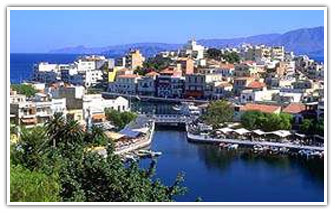 The town center of Agios Nikolaos is a bottomless lake, which is actually not a lake because it is connected to the sea and is not bottomless because it does not go all the way to the other side of the earth. But it is deep enough for the retreating Germans to dump all their tanks during WWII, and nobody has seen them since. Now the descendants of those same Germans can frolic in the sea and in the pubs with the descendants of the British people they fought, while being served by the ancestors of the farmers who defended their land with muskets against those tanks at the bottom of the bottomless lake.
The town center of Agios Nikolaos is a bottomless lake, which is actually not a lake because it is connected to the sea and is not bottomless because it does not go all the way to the other side of the earth. But it is deep enough for the retreating Germans to dump all their tanks during WWII, and nobody has seen them since. Now the descendants of those same Germans can frolic in the sea and in the pubs with the descendants of the British people they fought, while being served by the ancestors of the farmers who defended their land with muskets against those tanks at the bottom of the bottomless lake.
Indeed ‘Agios' as it is called in it's shortform, is an interesting town, somewhat less so in the summer when it is so packed with tourists that the local buses can barely get through the streets. Nearby is the Elounda Beach, one of the most well known and successful resorts in the country.
There are enough sandy coves and beaches along the coast so you can get away from the crowds if you want though you probably won't find solitude unless you head inland.
Although 'Agios' once had the reputation of a party town, the area is now more likely to attract couples, young and older, and has a charm which is a far cry from the popular image which is still being banded about by guide books which were written ten or fifteen years ago
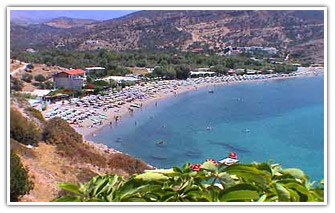 These coastal villages of Crete have a lot in common. At one time they were remote villages with beautiful beaches, inexpensive rooms and small tavernas. Now they are built up with hotels, tourist shops and wild nightlife. But this is the case with lots of places in Greece and particularly Crete and if you are here in the summer you may as well enjoy it.
These coastal villages of Crete have a lot in common. At one time they were remote villages with beautiful beaches, inexpensive rooms and small tavernas. Now they are built up with hotels, tourist shops and wild nightlife. But this is the case with lots of places in Greece and particularly Crete and if you are here in the summer you may as well enjoy it.
Anyway we are not all traveling monks and recluses looking for olive groves on empty beaches where we can contemplate the success and failures of our lives.
Some of us like to party at night and lay out on the beach and watch guys or girls in their bathing suits by day and these beaches are perfectly suitable. Plakias is 2 kilometers of tanned (and often lobster red), young and old bodies. Matala is a coved beach with the hippy caves made famous by life magazine in the late sixties and thus changed forever. In the winter of 1973 Matt Barrett stayed in these caves until one day he was awakened by policemen led by priests who evicted them because they were actually mausaleums. In fact several of the caves had skeletons in the carved out beds they were sleeping in.
Agia Galini is a full blown tourist resort however there are three good reasons to recommend going there. The sun is usually shining there, the people are nice, and I can't remember the third. That being said, any of these places is fine during the off-season and being the southernmost part of Greece, they can be a little warmer in the winter.
 As for what to do in Chania it's a case of passing the day until the sun goes down and the lights of the cafes, restaurants and bars around the harbor come on and life begins. Like most harbor towns the expensive cafes have taken the best spots on the waterfront and the cheaper and more traditional restaurants are on the fringes and the back streets.
As for what to do in Chania it's a case of passing the day until the sun goes down and the lights of the cafes, restaurants and bars around the harbor come on and life begins. Like most harbor towns the expensive cafes have taken the best spots on the waterfront and the cheaper and more traditional restaurants are on the fringes and the back streets.
There are also some interesting non-traditional restaurants scattered around the old town which you will come across in your wanderings. Most of the bars, discos and nightclubs are located in the inner harbor. For traditional Greek music in a traditional Greek setting try the Café Kriti at 22 Kalergon, the next street up parallel to the inner harbor. The beaches are to the west and for a town beach they are quiet pleasant, but can fill up in the summer. Restaurants line the waterfront so you can enjoy a good meal by the sea after toasting in the sun. But, for adventurous travelers to be in Crete without a car is like being in Manhattan without a wallet. Your days should be spent exploring the island. If you came to lay out on the beach and watch people you should be at Elounda beach or Ag Nikolaos.
Antiquities in this area include Phalassarna with its Cyclopean walls, tombs and sculptures carved out of stone, the ancient city of Aptera, about 15kms from Hania south of Souda, where there is a Roman theatre with enormous vaulted cisterns, a temple of Demeter and the Cyclopean walls.
From the Byzantine era there is the Monastery of Our Lady of the Angels or Gouvernetou with an impressive facade, the Rotonda of Archangel Michael with mosaic floors and frescoes and the Agia Triada monastery with a fine gate built in 1632.
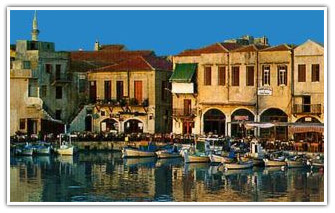 Another option for a port of arrival is the city of Rethymnon which is a mixture of high end tourist resorts and a traditional inner harbour of old buildings. Most of the tourist activity and nightlife is located on the road behind the town beach, but some of the best beaches on the island are a short distance away to the west where development is not as advanced as it is toward Heraklion. There are long stretches of sand and you may find yourself alone, but be aware that there can be strong currents and there are no lifeguards.
Another option for a port of arrival is the city of Rethymnon which is a mixture of high end tourist resorts and a traditional inner harbour of old buildings. Most of the tourist activity and nightlife is located on the road behind the town beach, but some of the best beaches on the island are a short distance away to the west where development is not as advanced as it is toward Heraklion. There are long stretches of sand and you may find yourself alone, but be aware that there can be strong currents and there are no lifeguards.
Rethymnon is thought by many to be the most cultural city on Crete and it is similar in style to Chania with it's charming Venetian quarters of winding streets and beautiful balconies.
The city's ancient ancropolis is Palekastro Hill. A 16th century fortress stands on the hill and massive walls provide beautiful views over the town and harbour. It's a great site to explore.
The Arkadiou Monastery between Rethymnon and Iraklion is a 5th century holy site that became a symbol of Cretan restistance on November 9th 1866 when hundreds of refugees and revolutionaries chose death over surrender to the Turks and blew themselves to pieces with the gunpowder that was being stored there by the Cretan Revolutionaries. The monastery was rebuilt again and is well worth the visit.
